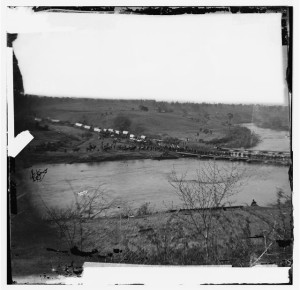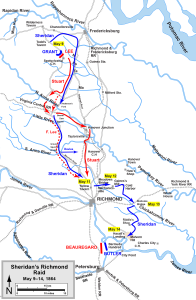According to Civil War clippings at the Seneca Falls public library, the 8th New York Calvary was home on furlough in March 1864 and H.B. Compson, one of the regiment’s members from Seneca County, had recently been promoted. Back at the front the 8th NY Cavalry took part in Philip Sheridan’s raid on Richmond. Here’s Captain Compson’s account.
From a Seneca County, New York newspaper in 1864:
From the 8th New York Cavalry.
ON PICKET, NEAR MALVERN HILL,
May 16th, 1864.
DEAR FATHER: – As I have not written home in some time I thought perhaps you would like to hear from me. I am well at present and as you will see by the heading of this letter some distance from our winter quarters on the banks of the Rapidan. After arriving at camp from home I found the army making great preparations for a forward movement, and on the first of May all was in readiness to move, and the night of the third the Grand Army of the Potomac was under way for the Rapidan river. The 8th New York Cavalry had the honor of taking the advance. We arrived at Germania Ford at midnight, and waited until daylight, then charged across. We met with but little opposition after our division had all crossed; after which we took up the line of march in the direction of Chancelorsville. The Infantry following after we camped about eight miles from the river. On the 5th we marched in the direction of Orange Court House, met a division of Stuart’s Cavalry, had a severe fight in which I had my horse shot. (In return I took the lift of a Reb. as the boys all say,) I charged the whole division with my squadron, for which I received great praise, for the General says I saved over 200 of our men who were surrounded by the enemy. We kept with the Army of the Potomac scouting around and skirmishing with the enemy until the 9th, when we had orders to march, the direction we did not know, for it was to be a secret movement. The whole cavalry Corps was to march, and at 1 o’clock we were on our way. We marched in the direction of Fredericksburg, then took a south-easterly course across the Ny, Po, Ta and the Mat Rivers and camped for the night on the banks of the North Anna river. On the morning of the 10th we were off at an early hour; crossing the river we went to Beaver Dam Station on the Orange and Richmond Railroad, captured two large trains of cars loaded with rations for Lee’s army, destroyed them and about 3,000,000 dollars worth of property, besides, at the depot ready for shipping, cut the telegraph with which Lee communicated with Richmond, tore up the track for several miles, then marched to Hanover Junction, destroyed property and tore the railroad up at that place, then struck across to the South Anna and camped for the night. On the 11th we took our line of march across the river, burned the bridge over South Anna, then marched to a place called Hungary, on the railroad 12 miles from Richmond. Here we destroyed the track and telegraph wires, again meeting Stuart’s Cavalry, had a severe fight, whipped them out, captured 3 pieces of artillery, and 150 prisoners. We then marched within 6 miles of Richmond, camped until midnight, then took the road leading to the rebel capital and at daylight we found ourselves to our great surprise within the fortifications of the so-called capital of the Southern Confederacy. One mile and a half from that noted traitorous city we surprised and captured their out post pickets. They put torpedoes in the road which exploded, but did very little damage to us. They mustered all the troops they had about the city and throwed [sic] them against us to keep us back and they needed every one they had for we drove them at every point until about 11 o’clock when they received reinforcements of two Brigades of Infantry. Our General thought it advisable to withdraw, and about 12 o’ cl’k [sic] our troops began to cross the Chickahomany [sic] river at Mellow [Meadows?] Bridge. We had hard work to cross for the enemy held the other end of the bridge, but we soon sent them flying in all directionr [sic] and at 4 o’clock P.M., our gallant corps was all safe across the famous river. We passed through Mechanicsville, the battle ground of McClellan, then marched the same route that he did in his retrograde movement from before Richmond. Saw the graves of many of his brave men who fell in that great struggle. We camped all night at Gaine’s Mills, then marched to that ever memorable battle ground Malvern Hill, where McClellan had his last struggle with the enemy in his retreat from the rebel capital. We arrived there about 4 o’clock. This place is within sight of the James river, and our gun boats can protect us. This made us six days and nights in the enemy’s lines with no forage or rations only what we could find on our route. Our horses are very tired and we are completely worn out, but a few days will recruit ourselves and our horses so we will be ready to march wherever our country needs us. Our raid amounted to a great destruction of property, estimated at about $4,000,000. We captured 450 prisoners, re-captured 300 of our own men who had been taken from Grant’s army and were on their way to Richmond. Here we have drawn rations and forage for ourselves and horses and will probably stay here a few days. I think Richmond will fall before the fourth of July. Our troops are gaining a little every day. General Butler is having a heavy battle to-day, and we can hear his guns. We have traveled 150 miles in six days. Stephen Griggs is missing, we do not know whether he was killed or taken prisoner. I remain, your affectionate son, H.B. COMPSON,
Capt. 8th N.Y. Cavalry.
Hal Jespersen’s map of Sheridan’s Richmond Raid is licensed by Creative Commons


